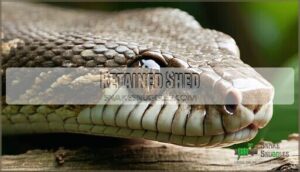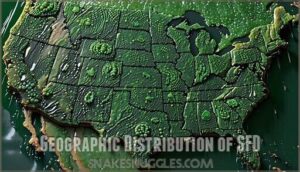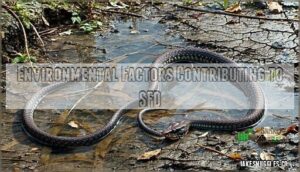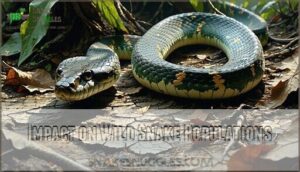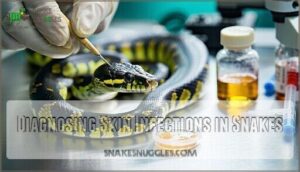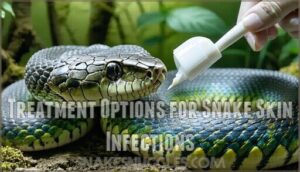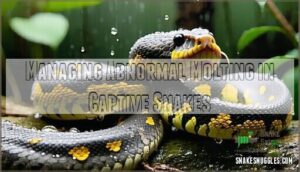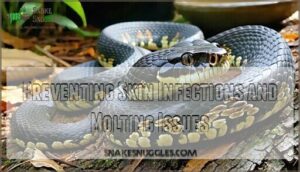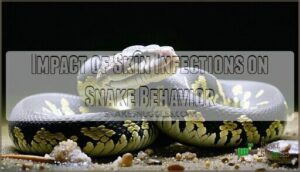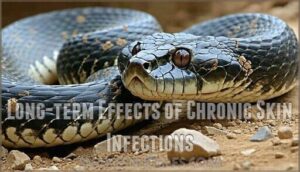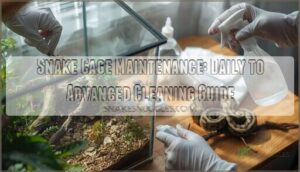This site is supported by our readers. We may earn a commission, at no cost to you, if you purchase through links.

These issues often stem from poor humidity levels, bacterial or fungal infections like snake fungal disease, or underlying health problems.
Watch for retained shed pieces, patchy shedding patterns, or unusual skin discoloration.
Environmental factors like dirty substrates and inadequate temperatures can trigger these conditions.
While some shedding hiccups are normal, persistent problems signal deeper issues that need veterinary attention.
The good news? Most skin infections are treatable when caught early, and simple husbandry adjustments can prevent future complications.
Table Of Contents
- Key Takeaways
- Common Causes of Snake Skin Infections
- Recognizing Symptoms of Abnormal Snake Molting
- Snake Fungal Disease (SFD): a Growing Concern
- Diagnosing Skin Infections in Snakes
- Treatment Options for Snake Skin Infections
- Managing Abnormal Molting in Captive Snakes
- Preventing Skin Infections and Molting Issues
- Impact of Skin Infections on Snake Behavior
- Long-term Effects of Chronic Skin Infections
- Emerging Research in Snake Skin Health
- Frequently Asked Questions (FAQs)
- How can I tell if my snake is sick?
- What are some specific symptoms of common illnesses in snakes?
- Why is shedding a concern for snake health?
- What are some signs of respiratory problems in snakes?
- What are some behavioral changes that may indicate snake illness?
- When should I seek veterinary care for my snake?
- What does a skin infection look like on a snake?
- What are the symptoms of snake fungal disease?
- How to tell if a snake has an infection?
- What does snake skin rot look like?
- Conclusion
Key Takeaways
- Watch for early warning signs – You’ll spot skin infections through crusty patches, retained shed pieces, cloudy eyes, and patchy shedding that won’t come off normally.
- Fix your husbandry first – Most skin problems stem from poor humidity (aim for 50-60%), dirty substrates, wrong temperatures, or stress from improper handling.
- Don’t wait to get help – Snake Fungal Disease and bacterial infections spread fast and can cause permanent scarring or death if you delay veterinary treatment.
- Prevention beats treatment – You’ll avoid most skin issues by maintaining clean enclosures, proper humidity, quarantining new snakes, and doing weekly health checks.
Common Causes of Snake Skin Infections
You’ll find that snake skin infections usually start with things like bacteria, fungi, parasites, or even a bit too much stress and bad living conditions.
If your snake’s home is as messy as a teenager’s room or their diet is off, skin problems can pop up fast due to bad living conditions.
Bacterial Infections
Regarding snake skin infection, bacterial infections are like uninvited guests that slip in through tiny wounds.
Infection sources include dirty enclosures and rough handling. If left unchecked, these bugs can cause nasty sores or even systemic infections—think trouble that spreads beyond the skin.
Good wound care and swift skin infection treatment with antibiotics are key. Watch out for antibiotic resistance, though.
Preventative measures—like cleaning habitats—work wonders to keep your snake’s scales sparkling.
Fungal Infections
Every snake owner dreads hearing “snake fungal infection.”
Fungal infections, especially snake fungal disease SFD caused by the ophidiomyces ophiodiicola fungus, can lead to flaky skin, weird sheds, and even serious health risks.
Watch for signs—early SFD prevention is key.
Environmental spread and emerging fungi are real threats, and antifungal resistance is growing.
Use antifungal medications as prescribed—don’t skip doses!
Parasitic Infestations
If you’ve ever spotted your snake scratching like it’s got the Monday blues, you might be dealing with parasitic infestations. Mites, ticks, roundworms, and even protozoan parasites can trigger skin abnormalities or a full-blown snake skin infection.
Quick action with Mite Identification, Tick Removal, and Roundworm Treatment keeps things under control.
- Watch for excessive rubbing
- Inspect for tiny moving dots (mites)
- Seek veterinary care for stubborn infestations
- Preventing reinfestation is key
Environmental Factors
While parasites can cause plenty of headaches, environmental factors are the real puppeteers behind many snake skin woes.
Bad snake husbandry—like poor enclosure hygiene or ignoring humidity levels—sets the stage for skin infections and abnormal molting. Habitat degradation, climate change, and pollution exposure only crank up the pressure.
Keep your snake’s world healthy by:
- Watching humidity control in enclosures
- Providing proper substrate for shedding
- Maintaining ideal enclosure conditions
- Ensuring the right temperature and lighting
A happy snake starts with a safe, balanced home, and maintaining these conditions is crucial for preventing skin infections.
Nutritional Deficiencies
If you skimp on calcium or let a Vitamin Imbalance slide, your snake’s skin will show it—think dry scales, incomplete shed, or even a nasty snake skin infection.
Don’t overlook Hydration Importance or Prey Gutload, but watch out for Supplementation Risks.
Good snake husbandry means covering all nutritional deficiencies, so your scaly buddy sheds like a champ!
Stress-induced Skin Problems
Unlike missing vitamins, stress sneaks up and triggers all sorts of snake skin infection and molting problems.
High Cortisol Impact from Handling Stress or loud noises can lead to immune suppression, making your snake prone to stressinduced skin problems and abnormal shedding.
Try these tricks:
- Fine-tune Enclosure Design for calm.
- Limit unnecessary handling.
- Watch for Behavioral Changes.
- Tweak environmental factors to reduce stress.
Recognizing Symptoms of Abnormal Snake Molting
You’ll want to keep a close eye on your snake’s shedding, since abnormal molting can show up as stuck skin, patchy sheds, or even cloudy eyes that look like your snake forgot its sunglasses.
Spotting these signs early lets you fix problems before your snake starts looking like it’s wearing last season’s scales.
You can address the issues by taking appropriate action to ensure your snake’s health, and this is crucial for maintaining its well-being, especially when abnormal molting occurs.
Retained Shed
When you spot a retained shed or stuck shed—especially around the eye caps—it’s a flashing neon sign for snake molting problems.
Boost humidity levels and add shedding aids like rough branches.
Never yank at the stubborn skin; you’ll risk a snake skin infection.
Preventative care and attention to dysecdysis in snakes keep abnormal shedding from becoming a bigger headache.
Patchy Shedding
After dealing with a retained shed, you might notice your snake’s skin peeling off in random patches.
Patchy shedding isn’t just a messy look—it’s a red flag for snake molting problems and possible dysecdysis in snakes.
Causes can range from low humidity to stress or even underlying snake skin issues.
For Identification, check for uneven, flaky skin.
Prevention starts with proper humidity and a rough object for rubbing.
Treatment means fixing those conditions and maybe a quick vet visit.
Ignoring patchy shedding can lead to complications, so don’t brush it off, as it may cause dysecdysis or other snake skin issues.
Incomplete Shedding
Every snake keeper runs into incomplete sheds, or dysecdysis in snakes, at some point.
If you see patches of retained shed or stubborn eye caps, it’s time for action.
Low humidity is a usual suspect—think “desert in a box.” Use shedding aid tools and boost moisture to help.
Don’t ignore retained eye caps; they’re troublemakers.
Staying on top of humidity importance keeps abnormal molting and other snake skin issues at bay.
Shedding Frequency Changes
Noticing your snake’s shedding frequency changes? Don’t brush it off! Shedding frequency is a key health indicator.
Watch for these:
- Age factors—older snakes shed less often.
- Nutritional shifts—diet changes can speed up or slow down shedding.
- Environmental stressors—even minor changes can trigger abnormal molting.
If things seem off, incomplete shedding or infection might be brewing—call your vet! It’s crucial to monitor your snake’s health closely and address any issues promptly to prevent serious health problems.
Dysecdysis Complications
When your snake struggles with dysecdysis complications—like retained shed or eye cap retention—it’s not just a bad hair day.
Incomplete shedding can cause eye damage, increase infection risk, and slow growth.
Watch for signs like cloudy eyes or stuck skin.
Boost humidity, add rough surfaces, and address dehydration impact to prevent scale rot and constriction issues from abnormal molting.
Snake Fungal Disease (SFD): a Growing Concern
You might think your snake’s worst enemy is a stubborn shed, but Snake Fungal Disease (SFD) is quickly becoming a much bigger threat.
This nasty skin infection, caused by the fungus Ophidiomyces ophiodiicola, is spreading fast and can cause serious problems for snakes all over North America and beyond, due to the serious problems it poses.
Ophidiomyces Ophidiicola Fungus
A sneaky troublemaker, Ophidiomyces ophidiicola fungus is the mastermind behind snake fungal disease (SFD), or ophidiomycosis.
Its Fungal Morphology lets it thrive in soil, making Environmental Prevalence a real headache.
Transmission Vectors include direct contact or contaminated habitats.
Thanks to its Genetic Diversity and Virulence Factors, this fungus causes stubborn snake skin infections that are tough to beat.
Geographic Distribution of SFD
If you’re wondering where snake fungal disease SFD likes to hang out, look east.
The geographic distribution of SFD is centered in the eastern United States, but don’t let that fool you—spread patterns suggest it’s sneaking into new regions.
Environmental factors, like wet weather, boost its reach.
Experts warn future projections may show SFD origins spreading even further.
The disease is caused by the dermatophyte fungus Ophidiomyces and can lead to population declines.
Species Susceptibility
If you’re caring for Garter Snakes, Rattlesnakes, or other captive snakes, keep an eye out—species susceptibility to snake fungal disease SFD varies wildly.
Young snakes and those with a weak immune response are easy targets for the ophidiomyces ophiodiicola fungus.
Rattlesnake vulnerability is high, but no snake species is truly off the hook, regardless of geographic variation.
Maintaining proper husbandry is critical to avoid common snake skin issues, especially to prevent SFD.
Environmental Factors Contributing to SFD
Plenty of environmental factors are fueling the spread of snake fungal disease SFD.
Climate Change, Habitat Loss, and Pollution Exposure all play a part.
The ophidiomyces ophidiicola fungus thrives when snakes are stressed or crowded.
Here’s what you should watch for:
- Soil Composition changes
- Prey Contamination
- Increased humidity
- Polluted water sources
- Loss of shelter, which can be caused by Habitat Loss and Pollution Exposure.
Impact on Wild Snake Populations
When snake fungal disease (SFD) hits wild snakes, you see more than just sick reptiles—it’s a ripple effect.
Population decline kicks in, genetic diversity shrinks, and ecosystem disruption follows.
The ophidiomyces ophiodiicola fungus, paired with habitat loss and other environmental factors, makes things worse.
Conservation efforts matter now more than ever to protect wild snakes from devastating skin infections.
Diagnosing Skin Infections in Snakes
If your snake starts looking a bit rough around the edges, you’ll want to know how vets figure out what’s really going on with its skin.
Diagnosing these infections means using tools like skin scrapings, blood tests, and sometimes even X-rays—no magic wands, just good science.
Physical Examination Techniques
Good physical examination techniques are your first line of defense.
Start with posture assessment and movement observation. Don’t be shy—gently run your hands along your snake for skin palpation and hydration check.
Watch for these warning signs:
- Discolored or flaky scales
- Unusual lumps or bumps
- Thickened or crusty skin
- Lethargy or odd movement
Stay curious—your snake depends on you to notice any warning signs.
Skin Scraping and Culture Tests
After a hands-on exam, your vet might suggest skin scraping and culture tests.
Here’s how it works: they’ll take a tiny sample collection from your snake’s skin and place it on different culture mediums.
After an incubation period, labs check for bacterial skin infection or fungal infections.
Fungal identification can take a bit longer, so don’t sweat the wait.
Result interpretation helps pinpoint what’s behind the abnormal molting or snake skin infection.
Biopsy Procedures
When other tests just don’t cut it, biopsy procedures step in as the gold standard for diagnosing tricky snake skin infections.
Your vet will numb a small spot, collect a tissue sample, and send it off for detailed tissue analysis. It’s quick, and most snakes barely notice.
- **Worried about Procedure Risks?
It’s minimal and handled with care.
- **Ethical Considerations?
Always top of mind for vets.
- **Diagnostic Accuracy?
Biopsies often reveal what skin scraping and culture tests miss—giving you peace of mind.
Blood Tests for Underlying Conditions
Ever feel like your snake’s skin infection is a puzzle missing a few pieces?
Blood tests for underlying conditions help your vet check Organ Function, Immune Response, Nutritional Status, Toxin Levels, and Inflammation Markers.
These tests give you the big picture on snake health and reptile skin disease, guiding smart veterinary care.
Ask questions—your curiosity helps your snake thrive!
Imaging Studies for Severe Cases
When snake skin infections get serious, your reptile veterinarian might suggest imaging studies for severe cases.
Think of X-rays, CT scans, ultrasounds, or even MRI applications as detective tools—they help spot what’s going on beneath the scales.
These tests can uncover things you can’t see, like hidden bacterial infections or fungal infections causing trouble.
Sometimes, an image-guided biopsy is needed to pinpoint the problem.
Here’s what these tools help with:
- Reveal X-ray findings for internal masses
- CT scan uses for complex cases
- Ultrasound benefits for soft tissues
- Assess organ health
- Guide surgical planning
Treatment Options for Snake Skin Infections
When your snake’s skin starts looking rough or shedding goes haywire, you’ll want to know what treatments actually work.
From antifungal creams to a bit of snake spa care, you’ve got options to help your scaly friend heal and shed like a pro again.
Topical Antifungal Medications
Your snake’s skin care routine just got technical! Topical antifungal medications like miconazole pack a punch against stubborn fungal infections, while clotrimazole resistance is rare but worth watching.
Always clean the area first—proper application methods matter. These antifungals are great for preventative use, but monitor for side effects like irritation.
Many owners buy miconazole products for their snakes. When in doubt, call your reptile vet!
Systemic Antibiotics for Bacterial Infections
When you spot pus-filled sores or red, swollen patches, it’s time to think about systemic antibiotics for bacterial infections. Don’t play guessing games—Antibiotic Resistance is real!
Always check Dosage Calculation and Administration Routes with your vet. Watch for Side Effects and stick to the proper Treatment Duration.
Snake skin infections need serious, science-backed snake care. Many owners find snake antibiotics readily available.
- Monitor for side effects like lethargy or appetite loss
- Use antibiotics only as prescribed
- Hydrate to protect kidney function
- Complete the full treatment course
Antiparasitic Treatments
If you’re dealing with snake skin infections from pesky parasites, antiparasitic treatments are your go-to.
Ivermectin use, fenbendazole dosage, and praziquantel efficacy all play a role in kicking out mites and worms.
Always follow your vet’s advice—mistakes can backfire.
Good reptile skin care starts with resistance management and preventative measures like quarantine and cleaning to avoid future parasitic infestations, including the use of preventative measures.
Supportive Care and Fluid Therapy
After tackling parasites, you’ll want to focus on supportive care and fluid therapy.
Hydration methods like oral, subcutaneous, or even intravenous fluids keep your snake’s body running smoothly, especially during snake skin infections.
Don’t forget Nutritional Support—offer easy-to-digest meals to help your buddy regain strength.
Keep their enclosure warm for proper Thermal Regulation and watch for signs of pain or discomfort.
Good Wound Management and Pain Management make a world of difference.
Stay alert, and you’ll keep reptile health and snake health on track!
Surgical Interventions for Severe Cases
When your reptile buddy’s skin infection—be it scale rot, blister disease, or stubborn Snake Fungal Disease (SFD)—won’t budge, surgical interventions for severe cases might save the day.
Here’s what your vet may do:
- Debridement Techniques: Remove dead or infected tissue.
- Lesion Removal or Grafting Options: Excise stubborn spots, sometimes using grafts.
- Drain abscesses or fluids.
- Biopsy for diagnosis and Post-op Care, including Pain Management.
Recovery’s possible with patience and good aftercare!
Managing Abnormal Molting in Captive Snakes
When your snake starts shedding in patches or struggles to peel off old skin, it’s time to step in and help.
You’ll need to fine-tune their habitat and maybe play “snake spa day” to keep their scales smooth and healthy.
Humidity Control in Enclosures
A little attention to humidity levels goes a long way for shedding success. Aim for 50-60% relative humidity—think “not too dry, not too swampy.”
Use Humidity Monitoring tools like a hygrometer, and consider Misting Systems for consistency. A water dish or humidity box can help, but don’t ignore Ventilation Needs.
Too much moisture can cause skin problems or even respiratory issues. Proper hygrometer selection is essential for accurate readings.
Balance is key—your snake will thank you with perfect sheds!
Providing Proper Substrate for Shedding
Once you’ve nailed humidity, it’s time to get picky about substrate. The right choice keeps your snake’s skin in top shape and makes shedding a breeze.
Here’s what matters:
- Substrate moisture—sphagnum moss or coconut fiber hold it well.
- Texture importance—avoid sharp or dusty bits.
- Burrowing needs—species matter!
- Abrasive surfaces—helpful for shedding aid and environmental enrichment.
These factors are crucial for maintaining your snake’s health and ensuring a comfortable environment.
Assisting With Stuck Shed Removal
If your snake’s skin looks patchy or just won’t budge, don’t fret.
Boost the humidity—Humidity Importance can’t be overstated. Try a warm soak for 15 minutes, but never leave them unattended.
Use Shedding Aids like damp sphagnum moss. Stick to Safe Techniques and call for Veterinary Assistance if the shed still clings tight.
Preventative Measures matter!
Addressing Underlying Health Issues
Sometimes, weird shedding points to bigger problems—think immune suppression, organ dysfunction, or even genetic predispositions.
Systemic illness, nutritional deficiencies, or stress factors often cause snake skin infections and patchy sheds.
Don’t just treat the surface—get a vet involved.
Addressing underlying health issues and stress-induced skin problems is key to treating snake molting and keeping your buddy healthy and smooth-skinned.
Skin issues may also point to parasites and mites, which require prompt attention to prevent further complications, ensuring the overall health and well-being of the snake, and maintaining its smooth-skinned appearance.
Nutritional Support for Healthy Skin
Good nutrition acts like armor for your snake’s skin, protecting against infections and ensuring smooth molts.
Supplement with calcium and vitamin D3, maintain proper hydration, and gutload prey with nutritious foods.
- Peace of mind: Knowing your snake gets balanced nutrition prevents scary skin problems
- Confidence boost: Watching perfect, complete sheds makes you feel like an expert keeper
- Relief: No more worrying about stuck shed or mysterious skin infections
Preventing Skin Infections and Molting Issues
You can’t just hope for healthy skin and perfect sheds—prevention requires active steps to create the right environment and catch problems early.
Taking proactive measures now saves you from dealing with serious infections and costly vet bills later.
Maintaining Optimal Enclosure Conditions
Your snake’s enclosure conditions can make or break their skin health.
Keep temperature gradients between 75-85°F with proper hiding spots on both ends.
Maintain humidity levels around 50-60% and choose appropriate substrate choices like cypress mulch or paper towels.
Good ventilation prevents stagnant air that breeds bacteria. Think of it as creating a five-star hotel for your scaly friend.
Regular Health Check-ups and Examinations
Beyond proper enclosure conditions, your snake’s health depends on consistent monitoring that catches problems before they escalate.
- Visual Inspections: Check your snake weekly for skin abnormalities, unusual lumps, or color changes that signal early detection opportunities.
- Weight Monitoring: Track body weight monthly using a digital scale to spot gradual declines that indicate underlying illness.
- Fecal Exams: Monitor droppings for parasites, blood, or unusual consistency that warrant immediate veterinary checkups for thorough snake health assessment.
Proper Hygiene and Sanitation Practices
After consistent check-ups, maintaining proper hygiene and sanitation practices becomes your next line of defense against infections. Think of your snake’s clean enclosure as their personal fortress—but even castles need regular cleaning.
Enclosure Cleaning should happen weekly using reptile-safe disinfectants. Water Sanitation means changing water every few days and scrubbing bowls thoroughly. Handling Protocols require washing hands before and after contact—you wouldn’t eat dinner with dirty hands, right?
To maintain a healthy environment, daily waste removal is also essential.
| Task | Frequency | Method |
|---|---|---|
| Enclosure Cleaning | Weekly | Reptile-safe disinfectant |
| Water Sanitation | Every 3-4 days | Scrub and refill |
| Waste Disposal | Immediately | Remove with tongs |
| Substrate Change | Monthly | Complete replacement |
Disinfecting equipment prevents cross-contamination between cleanings. Remember, maintaining ideal enclosure conditions starts with cleanliness—dirty environments invite trouble faster than you’d expect.
Quarantine Procedures for New Snakes
Quarantine isn’t just paperwork—it’s your collection’s lifeline.
Keep new snakes isolated for 30-60 days in separate enclosures with proper monitoring signs and hygiene protocols.
- Peace of mind: You’ll sleep better knowing diseases won’t spread
- Protection: Your existing snakes stay healthy and stress-free
- Smart investment: Prevention costs less than treating sick animals
Disinfect everything between handling sessions and conduct fecal exams during quarantine duration.
Stress Reduction Techniques
Through proper stress reduction techniques, you’ll dramatically lower your snake’s risk of skin infections and molting problems.
When snakes feel secure and comfortable, their immune systems function better, making them naturally resistant to disease.
Here are five key stress reduction techniques for maintaining ideal enclosure conditions:
- Enclosure Enrichment: Add hiding spots, climbing branches, and textured surfaces that encourage natural behaviors
- Handling Techniques: Minimize unnecessary contact and move slowly during essential care tasks
- Reducing Noise: Keep loud sounds and vibrations away from your snake’s environment
- Dim Lighting: Provide gentle, consistent lighting cycles that mimic natural day/night patterns
- Clean Environment: Maintain spotless conditions to create a stress-free environment.
These environmental enrichment strategies work together to keep your snake calm and healthy.
Impact of Skin Infections on Snake Behavior
When your snake develops skin infections or molting problems, you’ll notice some pretty clear changes in how they act around food and daily activities.
These behavioral shifts often serve as early warning signs that something’s wrong with their skin health, helping you catch issues before they become serious problems, which can be considered as early warning signs.
Changes in Feeding Patterns
When skin infections strike, your snake’s appetite loss becomes a red flag you can’t ignore.
Feeding frequency drops dramatically, and they’ll often reject their usual prey entirely.
You might notice regurgitation issues after meals or sudden prey preference changes – like only accepting smaller items.
Weight changes happen fast, and nutritional deficiencies follow.
These changes in feeding patterns signal your snake’s body is fighting something serious, not just being picky.
Increased Hiding or Defensive Behaviors
When your snake’s dealing with skin infections or patchy shedding, you’ll notice they’re pulling a disappearing act.
This behavioral change reflects their stress response and pain avoidance instinct.
Infected skin makes them feel exposed, triggering predator evasion mode and social isolation.
Think of it as their version of calling in sick – they’re just trying to feel safe while dealing with snake skin diseases like snake fungal disease SFD.
Reduced Activity Levels
Lethargy often signals trouble when skin infections like snake fungal disease (SFD) strike your pet.
Immune suppression from fighting infections leaves snakes exhausted, while thermoregulation issues and muscle weakness compound the problem.
You’ll notice hunting decline and energy conservation behaviors as your snake’s body redirects resources toward healing, making topical antifungal medications essential for recovery.
Abnormal Basking Habits
When your snake’s usual sunbathing routine goes sideways, it’s often your first clue something’s wrong.
Skin infections can make their favorite warm spot feel uncomfortable, causing them to avoid their usual basking duration or show unusual temperature preference.
You might notice frequency changes in their heating habits or strange positioning issues that disrupt their habitat gradient needs.
Watch for these abnormal basking habits:
- Avoiding their preferred basking spot entirely
- Staying under heat sources much longer than normal
- Constantly shifting positions while trying to warm up
- Choosing cooler areas when they’d typically seek warmth
- Appearing restless or uncomfortable during basking time
Snake fungal disease and other skin infections caused by Ophidiomyces ophidiicola often trigger these behavioral shifts.
Environmental factors contributing to SFD can make temperature regulation painful, so your snake might struggle to find that "just right" comfort zone they normally nail perfectly.
Changes in behavior, like excessive hiding signals, could also indicate discomfort.
Signs of Discomfort or Irritation
When your snake displays excessive rubbing against surfaces or shows agitated behavior, it’s likely experiencing discomfort from skin infections.
Hiding more than usual, reduced appetite, and erratic movements are telltale signs something’s wrong.
Watch for discolored scales or skin abnormalities – these abnormal behaviors often accompany skin lesions and indicate your pet needs veterinary attention.
Long-term Effects of Chronic Skin Infections
When chronic skin infections persist untreated, they can permanently alter your snake’s appearance and weaken its natural defenses against future health threats.
These ongoing infections create a cascade of problems that extend far beyond the initial skin damage, potentially affecting your snake’s ability to reproduce and survive in the long term, which can be influenced by the initial skin damage.
Scarring and Disfigurement
Beyond aesthetic concerns, chronic skin infections leave lasting marks that affect your snake’s quality of life.
Scar tissue forms when infections damage deeper skin layers, creating permanent reminders of past battles.
- Functional impairment – Rigid scar tissue restricts normal movement and flexibility
- Cosmetic effects – Permanent discoloration and texture changes alter appearance
- Behavioral changes – Disfigured snakes may become more defensive or reclusive
- Long-term prognosis – Scarred areas remain vulnerable to reinfection cycles
Compromised Immune System
When chronic skin infections persist, your snake’s compromised immune system becomes a weakened fortress against disease.
Immune system stressors like malnutrition effects and environmental toxins create perfect conditions for opportunistic infections to take hold.
Genetic predisposition can make some snakes more vulnerable, while nutritional deficiencies further weaken their natural defenses against future health threats, leading to a compromised immune system.
Reduced Breeding Success
When your snake’s skin stays constantly irritated, reduced breeding success becomes a harsh reality.
Here’s how chronic infections sabotage reproduction:
- Mating behavior changes as stressed snakes lose interest in courtship
- Egg viability drops substantially when females can’t maintain proper health
- Hatchling health suffers from weakened parental genetics and environmental factors contributing to SFD
Snake fungal disease from Ophidiomyces ophidiicola threatens population decline and genetic diversity.
Increased Susceptibility to Secondary Infections
Watch out—compromised immunity makes your snake a sitting duck for opportunistic pathogens.
Open wounds from existing skin infections become gateways for bacterial infection and fungal infections.
A weak immune system can’t fight multiple battles, leading to delayed healing and potentially dangerous systemic infections.
Knowing the signs of snake skin infections is essential for early intervention.
Address underlying stressors immediately.
Potential for Systemic Spread of Infection
When secondary infections overwhelm your snake’s defenses, the situation can escalate dangerously.
Bacterial or fungal infections don’t stay put—they’re like uninvited guests who refuse to leave and invite their friends over.
Here’s what happens when skin infections go systemic:
- Organ Involvement spreads infection to essential organs like liver and kidneys
- Immune Response becomes overwhelmed, creating treatment challenges for veterinarians
- Secondary Infections develop as weakened defenses can’t fight new threats
- Mortality Rates increase substantially without immediate systemic antibiotics for bacterial infections
Biopsy procedures help identify the culprit, but time’s ticking when infection spreads internally.
Emerging Research in Snake Skin Health
Scientists are making exciting breakthroughs in understanding snake skin health, from testing new antifungal treatments to studying how genetics might help some snakes fight off infections better than others.
You’ll want to know about these cutting-edge discoveries because they’re changing how we prevent and treat skin problems in both wild and captive snakes, which is a significant development in snake skin health.
Novel Treatment Approaches
While chronic infections leave lasting damage, revolutionary novel treatment approaches are transforming snake care.
Immunotherapy applications boost your snake’s natural defenses, while probiotic therapies restore healthy skin bacteria. Phage therapy targets specific bacterial infections with precision. Nanoparticle delivery systems enhance antifungal medications absorption, and gene editing techniques may soon prevent infections entirely.
| Treatment Type | Method | Benefits |
|---|---|---|
| Immunotherapy | Immune system boosting | Enhanced natural resistance |
| Probiotic Therapy | Beneficial bacteria restoration | Balanced skin microbiome |
| Phage Therapy | Targeted bacterial elimination | Precision infection control |
| Nanoparticle Delivery | Enhanced medication absorption | Improved topical effectiveness |
| Gene Editing | Genetic resistance enhancement |
Prevention-focused approach.
These advances complement traditional systemic antibiotics for bacterial infections, biopsy procedures, and supportive care and fluid therapy.
Genetic Factors in Disease Resistance
Your snake’s genetic makeup might determine its ability to fight off skin infections.
Researchers are discovering that Immune Gene Variants and MHC Diversity influence disease resistance.
Some snakes inherit stronger defenses against fungal threats, while Population Bottlenecks can reduce this natural protection.
Understanding Heritability Estimates helps breeders select healthier bloodlines for future generations.
Microbiome Studies of Snake Skin
Revolutionary discoveries about skin microbiome diversity are transforming how we perceive snake health.
These microscopic communities act as your snake’s first defense against skin pathogens, with microbiome and immunity working together to prevent infections like SFD.
Here’s what microbiome studies of snake skin reveal:
- Healthy snakes maintain diverse bacterial communities that outcompete harmful fungi
- SFD microbiome impact disrupts protective bacteria, increasing infection risk
- Husbandry microbiome effects show proper care preserves beneficial skin microbiology
Climate Change Impacts on Skin Infections
Climate change is turning up the heat on snake health problems.
Rising Temperature Effects and Humidity Changes create perfect breeding grounds for skin infections, especially snake fungal disease.
Environmental changes weaken your snake’s immune system through Immune Suppression, while Habitat Alteration forces snakes into crowded, moisture-rich spaces where Disease Vectors thrive.
Wildlife health faces mounting pressure as these climate change impacts spread infections faster than ever before.
Development of Preventive Measures
Modern veterinary science is revolutionizing how we protect our scaly companions from skin troubles.
Researchers are developing cutting-edge preventive measures that’ll keep your snake’s skin in tip-top shape:
- Proactive Husbandry protocols combining genetic screening with early detection systems
- Preventative Antifungals customized to your snake’s specific environmental needs
- Habitat Management strategies featuring environmental enrichment and ideal enclosure conditions
These breakthrough approaches focus on preventing skin infections before they start, maintaining ideal enclosure conditions, and providing nutritional support for healthy skin development.
Frequently Asked Questions (FAQs)
How can I tell if my snake is sick?
Like a detective examining clues, you’ll spot trouble through visible signs: abnormal shedding, skin lesions, cloudy eyes, lethargy, loss of appetite, unusual posture, or behavioral changes that signal something’s wrong.
What are some specific symptoms of common illnesses in snakes?
You’ll notice respiratory infections through wheezing, mouth breathing, and mucus discharge.
Snake Fungal Disease shows up as crusty skin lesions, facial disfiguration, and cloudy eyes.
Parasites cause visible mites, abnormal shedding, and behavioral changes like excessive rubbing, which can be signs of a serious infection.
Why is shedding a concern for snake health?
Perfect sheds mean healthy snakes, but incomplete molting traps bacteria under old skin, while smooth renewals indicate proper humidity and nutrition.
You’ll spot trouble when retained eye caps or patchy shedding appears.
What are some signs of respiratory problems in snakes?
You’ll spot respiratory trouble when your snake breathes with its mouth open, makes wheezing sounds, or shows thick mucus around its nose and mouth—clear red flags.
What are some behavioral changes that may indicate snake illness?
You’ll see changes in your snake’s eating habits, activity levels, and hiding behavior when they’re sick.
Decreased appetite, lethargy, excessive hiding, unusual aggression, or staying in unusual positions often signal health problems requiring veterinary attention.
The presence of these symptoms, such as lethargy, can indicate that your snake needs medical care.
When should I seek veterinary care for my snake?
Get veterinary help immediately if your snake shows severe symptoms like facial lesions, difficulty shedding, cloudy eyes, or stops eating. Don’t wait—early treatment prevents complications.
What does a skin infection look like on a snake?
Swollen scales signal serious trouble – you’ll notice thickened, crusty patches, cloudy eyes, blisters, lumps under skin, or facial disfigurement that screams infection.
What are the symptoms of snake fungal disease?
You’ll notice thickened, crusty skin lesions and scabs forming on your snake’s body. Look for blisters, swelling, and cloudy eyes that won’t clear up after shedding cycles completely.
How to tell if a snake has an infection?
Roughly 70% of wild snake skin infections now involve fungal causes rather than bacterial ones.
You’ll spot infections through visible lesions, scabs, swelling, cloudy eyes, abnormal shedding patterns, or behavioral changes like reduced appetite and activity levels.
What does snake skin rot look like?
You’ll spot dark, discolored patches on your snake’s skin that look wet or slimy.
The affected areas often appear black, brown, or grayish with a musty smell and soft, deteriorating texture underneath.
Conclusion
Studies show that 40% of captive snakes experience shedding complications at least once during their lifetime.
Recognizing snake skin infection and abnormal molting early can save your scaly friend from serious health issues.
You’ve learned the warning signs, from retained shed to fungal patches, and now you know when to call your exotic vet.
Remember, proper humidity, clean substrates, and regular health checks prevent most problems.
Your snake’s skin health reflects their overall wellbeing—stay vigilant and proactive.
- https://www.merckvetmanual.com/exotic-and-laboratory-animals/reptiles/bacterial-diseases-of-reptiles
- https://cwhl.vet.cornell.edu/disease/snake-fungal-disease
- https://pmc.ncbi.nlm.nih.gov/articles/PMC4345101/
- https://dnr.wisconsin.gov/sites/default/files/topic/EndangeredResources/sfdInWisconsin.pdf
- https://www.petplace.com/article/reptiles/pet-health/small-pet-health/reptile-small-pet-health/dysecdysis-shedding-problems

